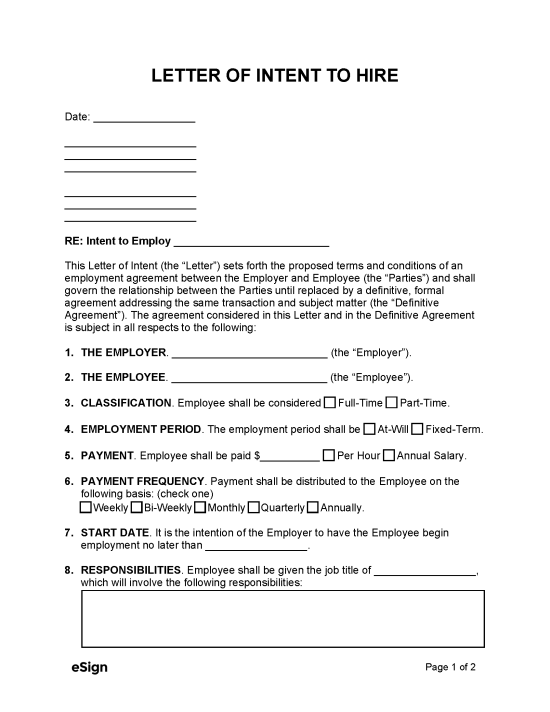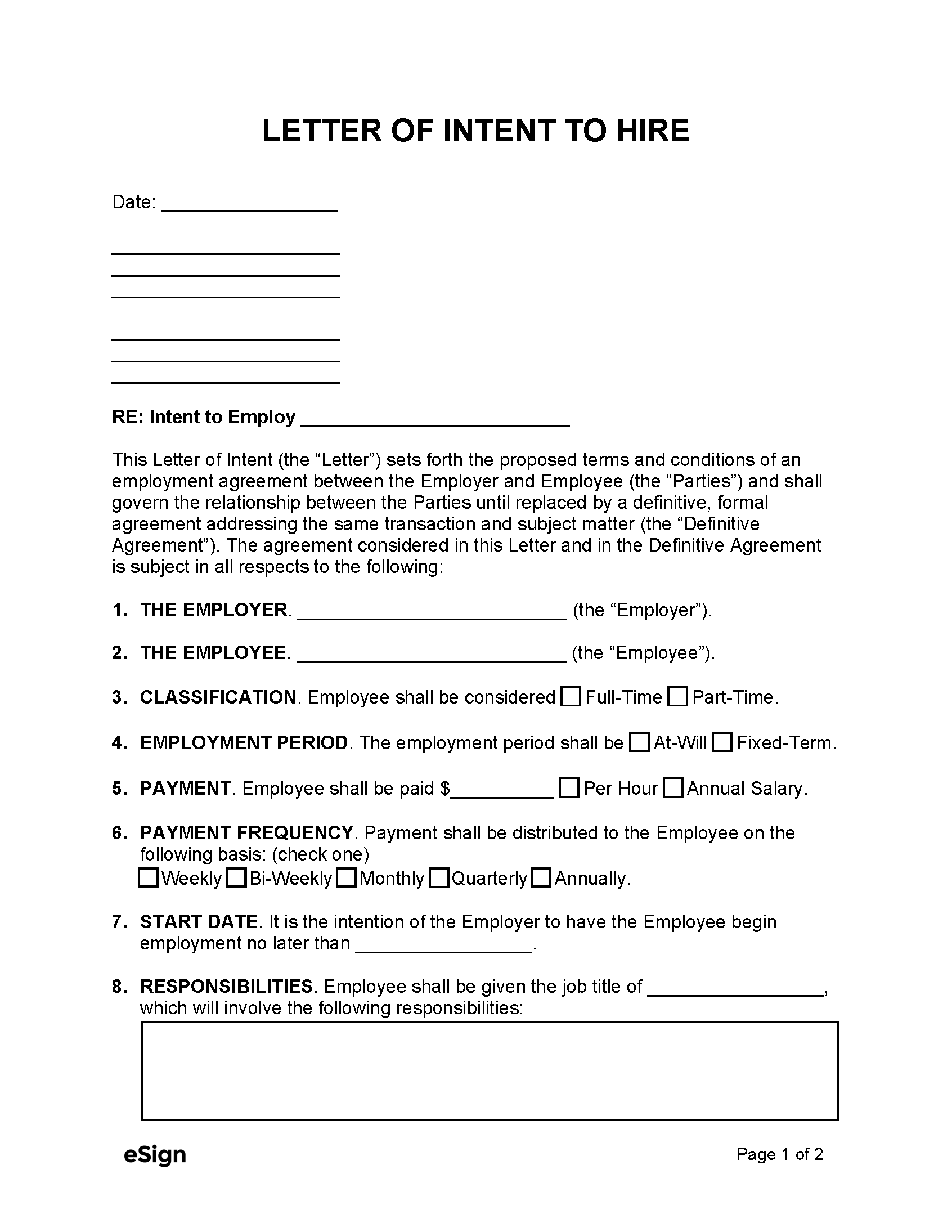What is a Letter of Intent to Hire?
Employers use a letter of intent to communicate the conditions of a job offer and demonstrate their willingness to hire the prospective employee. The applicant’s response can help the employer determine whether the individual is interested in the position or is looking for employment elsewhere.
Additionally, a letter of intent can help distinguish a company from other hiring businesses, mainly when recruiting top candidates in a niche or specialized market.
Not Legally Binding
Signing a letter of intent doesn’t obligate either party to enter into a legally binding employment contract. The parties are required to use “reasonable efforts” to negotiate an agreement, but if an agreement isn’t reached, they can back out of the arrangement without legal consequences.
How to Write
A letter of intent to hire outlines general terms before a potential employment agreement is signed. While the letter won’t be as long or comprehensive as a formal contract, it must convey enough information to help the applicant decide whether to accept or reject the offer.
Employer and Applicant Information
The letter of intent must specify the names of the employer and the person applying for the job, as well as each party’s mailing address.
Intent of the Letter
It must be apparent that the letter conveys the terms of a potential agreement and doesn’t represent a final employment contract between the parties.
Job Description
The letter must clearly and concisely describe the applicant’s work responsibilities. It should also specify whether the position is full-time or part-time and when the employee is expected to start.
Compensation
Employers must establish the potential employee’s hourly wage or salary and describe whether they’ll be paid weekly, bi-weekly, monthly, etc. Employers can also outline any benefits they intend to provide to the applicant.
Days Off
Terms for taking days off may be incorporated in the letter of intent, including whether the employee’s absences will be paid or unpaid.
Probationary Period
Companies may choose to implement a probationary period during which the employee can be fired without cause or warning.
Sample
Download: PDF, Word (.docx), OpenDocument
LETTER OF INTENT TO HIRE
Date: [DATE]
[SENDER (e.g., EMPLOYER) NAME]
[SENDER STREET ADDRESS]
[SENDER CITY, STATE, ZIP]
[RECIPIENT (e.g., EMPLOYEE) NAME]
[RECIPIENT STREET ADDRESS]
[RECIPIENT CITY, STATE, ZIP]
RE: Intent to Employ [EMPLOYEE NAME]
This Letter of Intent (the “Letter”) sets forth the proposed terms and conditions of an employment agreement between the Employer and Employee (the “Parties”) and shall govern the relationship between the Parties until replaced by a definitive, formal agreement addressing the same transaction and subject matter (the “Definitive Agreement”). The agreement considered in this Letter and in the Definitive Agreement is subject in all respects to the following:
1. THE EMPLOYER. [EMPLOYER NAME] (the “Employer”).
2. THE EMPLOYEE. [EMPLOYEE NAME] (the “Employee”).
3. CLASSIFICATION. Employee shall be considered [WRITE “full-time” OR “part-time”].
4. EMPLOYMENT PERIOD. The employment period shall be [WRITE “at-will” or “fixed-term”].
5. PAYMENT. Employee shall be paid $[EMPLOYEE WAGE] [WRITE “per hour” OR “annual salary”].
6. PAYMENT FREQUENCY. Payment shall be distributed to the Employee [PAYMENT FREQUENCY (e.g., WEEKLY)].
7. START DATE. It is the intention of the Employer to have the Employee begin employment no later than [EMPLOYMENT START DATE].
8. RESPONSIBILITIES. Employee shall be given the job title of [EMPLOYEE JOB TITLE], which will involve the following responsibilities: [DESCRIBE WORK RESPONSIBILITIES].
9. DAYS OFF. Employee shall have the option of taking [#] days off per year. The days off will be [WRITE “paid” OR “unpaid”].
10. INTENTION OF THE PARTIES. This Letter sets forth the intentions of the Parties to use reasonable efforts to negotiate, in good faith, a Definitive Agreement with respect to all matters herein. Notwithstanding paragraphs 10 through 11, which shall be legally binding, any legal obligations with respect to all other matters shall only arise if and when the Parties execute and deliver a Definitive Agreement.
11. GOVERNING LAW. This Letter shall be governed under the laws of the State of [STATE].
Employer’s Signature: ___________________ Date: [MM/DD/YYYY]
Print Name: [EMPLOYER NAME]
Employee Signature: ___________________ Date: [MM/DD/YYYY]
Print Name: [EMPLOYEE NAME]

